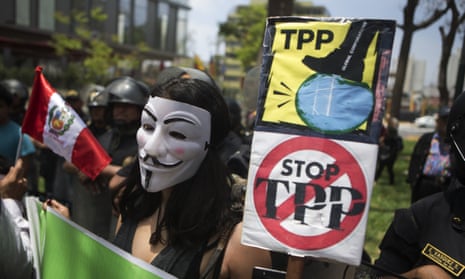What is the TPP?
The Trans-Pacific Partnership (TPP) is a 12-nation trade pact that would cut tariffs and deepen economic ties between the signatories. It also aims to simplify regulations and copyright laws so that member countries would have a more or less unified system.
In its most lofty form, it could create a new single market, similar to the European Union, with the current signatories comprising about 40% of the global economy.
While some tariffs would be slashed the moment the TPP is ratified, import taxes on certain “sensitive products” would be eliminated over time. Overall, more than 18,000 tariffs would be affected.
It is widely seen as a counter to China’s economic might in Asia, and the world’s second largest economy is notably absent from the list of signatories.
The 12 countries that signed the deal in February 2016 are the US, Japan, Australia, New Zealand, Canada, Malaysia, Vietnam, Singapore, Brunei, Mexico, Peru and Chile.
Why is it in doubt?
US president-elect Donald Trump has announced he would withdraw from the deal on day one of his term. “The TPP would be meaningless without the United States,” Japan’s prime minister, Shinzo Abe, has said.
While other members of the group scramble to save the deal that is a signature achievement of Barack Obama’s presidency, free trade deals like the TPP have traditionally been unpopular with the working-class voters who are thought to have elevated Trump to the White House.
Many believe trade liberalisation has harmed jobs in the American heartland, and that the TPP would increase competition between the workers in the group’s various countries. Critics have complained about the seven years of top secret negotiations and have made accusations that the TPP only helps big businesses.
Many in Obama’s own party – including senators Bernie Sanders and Elizabeth Warren – are against the trade deal, along with traditional Democratic party supporters such as trade unions and environmentalists.
Free speech advocates have also raised flags over an attempt to unify copyright legislation among the members.
In a similar tone to the Brexit campaign, some were critical it would harm national sovereignty and move jobs overseas.
What happens next?
For the TPP to take effect, six countries representing 85% of the signatories’ GDP need to ratify the agreement. That drama will play out in the groups’ 12 legislatures, although Obama struck a deal with the US congress that means lawmakers would only approve or reject the pact, and have no ability to modify its contents. His administration has now conceded that it will not be ratified before he leaves the White House.
The TPP’s two biggest economies are the US and Japan, and if Trump follows through on his promise to withdraw from the pact it would send remaining states scrambling to salvage it.
What does this mean for China?
China declined to join the pact, feeling it was designed to isolate the country politically and economically, but the wider implications of the US going back on a trade deal that took seven years to negotiate will likely harm China in the long term.
“The US leaving TPP is a problem of America rejecting globalisation, and China is a beneficiary of globalisation and China is not willing to see the tide of globalisation ebb,” said Da Wei, an expert on the US at the China institute of contemporary international relations.
While some Chinese may be happy at what they see as a political failure for the US, ultimately “China disapproves of this; China is anxious about the retreat of globalisation”, Da said.
Trump’s wider trade rhetoric could damage US-China relations, with his promotion of “economic nationalism” at the centre of his frequent attacks on the world’s second largest economy.
Last week an editorial in the Communist party-controlled Global Times warned Trump: “Making things difficult for China politically will do him no good.”
